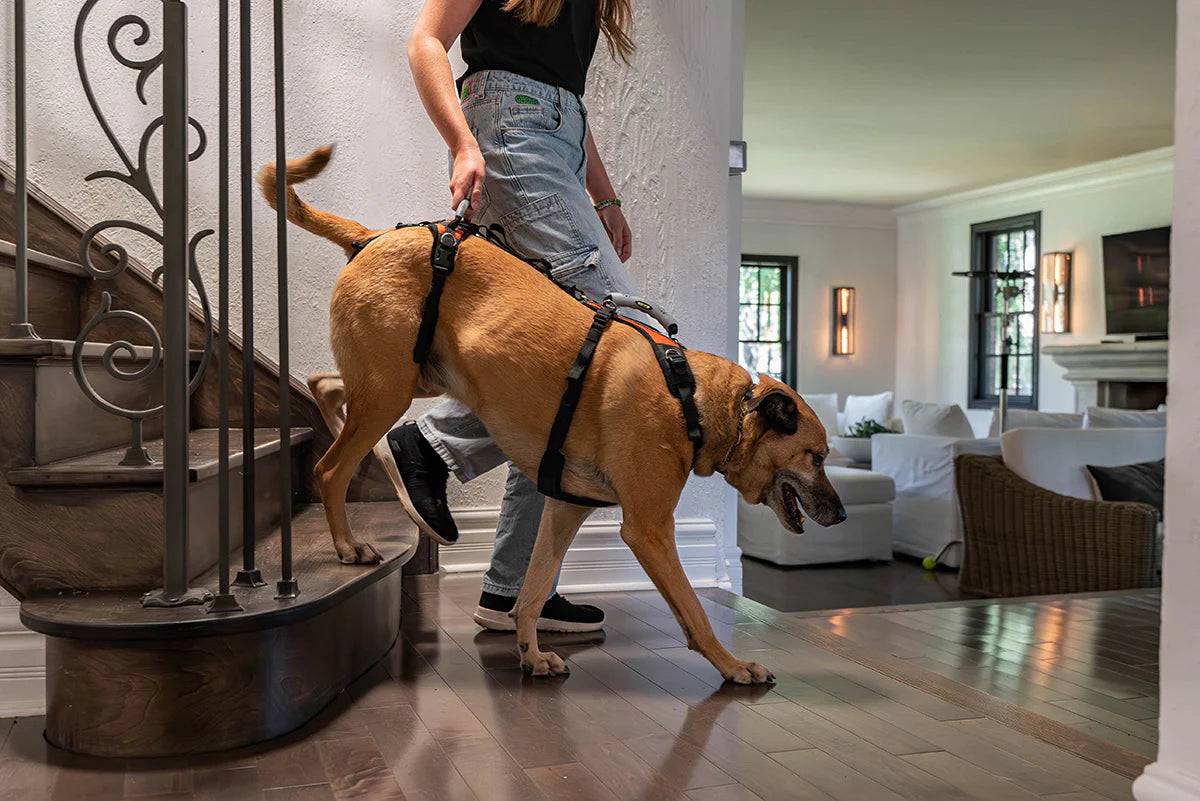What is Ataxia in Dogs? Types, Causes, Symptoms, and Treatment of Unbalanced Gait

Ataxia in dogs is a condition that affects coordination and balance. Dogs with ataxia exhibit an unsteady gait, difficulty walking, and poor muscle control. The condition arises from underlying neurological, musculoskeletal, or metabolic issues. While some causes of ataxia are mild and treatable, others may indicate serious health problems requiring long-term care.
Understanding ataxia, its causes, and available treatments is essential for dog owners. This guide explains the different types of ataxia, common symptoms, diagnostic procedures, treatment options, and how to provide the best care for affected dogs.
Types of Ataxia in Dogs
1. Cerebellar Ataxia
Cerebellar ataxia results from damage to the cerebellum, the part of the brain responsible for motor coordination. This type of ataxia often presents in young dogs with congenital or hereditary conditions.
Causes:
-
Congenital defects (e.g., cerebellar hypoplasia)
-
Brain tumors
-
Infections such as canine distemper virus
-
Inflammatory diseases affecting the central nervous system
Symptoms:
-
Head tremors
-
Uncoordinated movement, especially in the legs
-
Wide-based stance
-
Difficulty judging distance
2. Sensory (Proprioceptive) Ataxia
Sensory ataxia occurs when the spinal cord or peripheral nerves fail to send accurate information about limb position to the brain. This results in a loss of coordination.
Causes:
-
Spinal cord injuries
-
Intervertebral disc disease (IVDD)
-
Degenerative myelopathy
-
Nerve tumors or inflammation
Symptoms:
-
Dragging of the limbs
-
Knuckling (walking on the top of the paws)
-
Weakened reflexes
-
Difficulty standing
3. Vestibular Ataxia
Vestibular ataxia stems from dysfunction in the inner ear or brainstem, which affects balance and spatial orientation.
Causes:
-
Ear infections
-
Brain tumors
-
Head trauma
Symptoms:
-
Head tilt
-
Rapid eye movements (nystagmus)
-
Loss of balance
-
Circling or falling to one side
Common Symptoms of Ataxia in Dogs
Symptoms of ataxia vary depending on the underlying cause but commonly include:
-
Unsteady or wobbly gait
-
Stumbling or falling
-
Lack of coordination
-
Weakness in the limbs
-
Head tremors
-
Loss of balance
-
Difficulty standing
-
Changes in posture
-
Rapid eye movement
Recognizing these symptoms early can help in seeking prompt veterinary intervention.
Diagnosing Ataxia in Dogs
Diagnosing ataxia involves a thorough evaluation by a veterinarian, including:
1. Physical Examination
The vet assesses the dog’s gait, reflexes, and overall coordination to identify abnormalities.
2. Neurological Testing
Neurological exams help determine whether the issue originates in the brain, spinal cord, or peripheral nerves.
3. Imaging Tests
Advanced imaging may be required to identify structural abnormalities:
-
X-rays – Detect spinal injuries or disc issues
-
MRI/CT Scans – Provide detailed brain and spinal cord imaging
-
Electromyography (EMG) – Measures muscle and nerve function
4. Blood and Urine Tests
Laboratory tests rule out metabolic disorders, infections, and toxic exposure.
Treatment Options for Ataxia in Dogs
Medical Management
Treatment depends on the underlying cause:
-
Antibiotics for bacterial infections
-
Anti-inflammatory medications for inflammatory diseases
-
Steroids to reduce swelling in neurological conditions
-
Physical therapy for rehabilitation and muscle strengthening
-
Surgical intervention for spinal or brain tumors, IVDD, or fractures
Supportive Care
For chronic or untreatable conditions, supportive care improves quality of life:
-
Mobility aids such as harnesses or custom dog wheelchairs
-
Physical rehabilitation to maintain muscle strength
-
Proper nutrition to support nerve and muscle function
Caring for a Dog with Ataxia
1. Home Modifications
Adjusting the home environment helps prevent injuries:
-
Use non-slip mats on floors
-
Remove obstacles and hazards
-
Provide padded bedding for comfort
-
Use ramps instead of stairs
2. Mobility Assistance
Dogs with severe ataxia often struggle with mobility and balance, making everyday activities challenging. Assistive devices such as harnesses and dog wheelchairs can greatly improve their quality of life and prevent further injuries.
Dog Wheelchairs
A custom-built canine wheelchair provides essential support for dogs with ataxia by stabilizing their hindquarters or full body, depending on the severity of their condition. Benefits of using a dog wheelchair include:
-
Enhanced Stability – Helps dogs maintain proper posture and balance, reducing falls.
-
Increased Mobility – Allows dogs to walk, run, and play with greater ease.
-
Joint and Muscle Support – Reduces strain on weak or uncoordinated limbs, preventing further deterioration.
-
Confidence and Mental Well-being – Helps dogs regain their independence, reducing frustration and anxiety caused by mobility issues.
When selecting a wheelchair, it's important to choose one tailored to your dog’s specific condition. K9 Carts offers adjustable, lightweight wheelchairs designed for comfort and ease of movement. Proper fitting ensures the wheelchair does not cause discomfort and supports natural motion.
Harnesses and Slings
Slings and lifting harnesses like the Help ’Em Up are valuable tools for lifting and stabilizing dogs with ataxia, especially when navigating stairs or uneven terrain. They provide:
-
Lifting Support – Helps owners assist their dog in standing, walking, or climbing stairs without excessive strain on the dog’s body.
-
Improved Balance – Reduces the risk of falls by providing controlled assistance.
-
Post-Surgical Aid – Beneficial for dogs recovering from surgery who need temporary support.
A well-fitted harness, such as a rear-support harness or a full-body harness, ensures even weight distribution and maximum comfort. Owners should use a harness with handles for easy lifting and maneuverability.
By incorporating a wheelchair or harness into daily care, dogs with ataxia can maintain an active lifestyle, improve their strength, and enjoy a better quality of life.
3. Exercise and Rehabilitation
Low-impact activities help maintain strength and flexibility:
-
Hydrotherapy (swimming or underwater treadmill)
-
Passive range-of-motion exercises
-
Controlled leash walks for balance training
4. Dietary Considerations
A balanced diet supports nerve function and muscle health:
-
Omega-3 fatty acids for anti-inflammatory benefits
-
Vitamin B complex for neurological support
-
High-protein diets to maintain muscle mass
When to Seek Veterinary Help
Ataxia may indicate a serious health condition. Contact a veterinarian if your dog:
-
Suddenly develops ataxia
-
Shows worsening symptoms
-
Experiences pain or distress
-
Has difficulty eating or drinking
Early diagnosis and treatment improve outcomes and quality of life.
Helping Your Dog Live Comfortably with Ataxia
Dogs with ataxia can still lead fulfilling lives with the right care and support. By understanding their needs, providing assistive devices like wheelchairs, and ensuring regular veterinary care, owners can enhance their dog's mobility and well-being.
Custom dog wheelchairs from K9 Carts are designed to provide stability and freedom of movement for dogs with mobility impairments. These devices help dogs regain independence, stay active, and enjoy their daily routines despite neurological challenges.
With proper attention and a proactive approach, dogs with ataxia can continue to experience a high quality of life while maintaining their bond with their owners.








